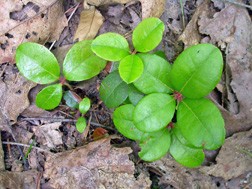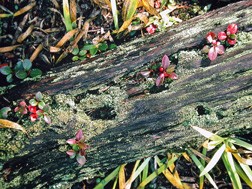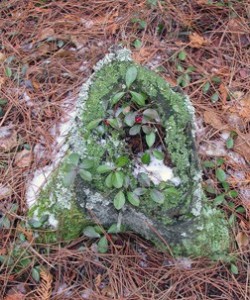Wintergreen – Beautiful and Invigorating
- Share
- Tweet
- Pin
- Share

Wintergreen leaves.
Come late October and early November, a wonderfully relaxed, yet, invigorating feeling overcomes many people. If all has gone according to hopes and plans, the garden and field crops have been harvested and stored in good shape. Storm windows and doors are in place, the chimney cleaned, weather stripping has been applied, and the stove wood that has been drying outdoors for the past year is piled neatly in the woodshed, under cover from the elements.
We welcome this refreshing and quiet time as winter lurks around the corner, poised and ready with the first snowfall. Perhaps the hushed relaxed feeling can be traced in large part to most of the deciduous trees’ loss of their leaves. Those swishing, rustling sounds of the leafy canopy will be missing in the outdoor scene for the next six months. One can, however, still enjoy the gentle whistling of the wind in the pines as well as the small leaf-holding beeches and oaks, but that’s an entirely different sound.
My all-time favorite environment for hiking during this season is the boreal or mixed northern forest. Florence Page Jaques, fine writer and wife of the famous northwoods artist Francis Lee Jaques, summed it up perfectly when she said of the boreal forest: “This country never knew a medieval time, it came straight from the primeval into today.” For some reason or other, the Balsam Fir trees add perfume to the atmosphere at this time, making it about the most wonderful air one could ever want to inhale.
Dressed in blaze orange, not wishing to resemble a deer in even the slightest way, I look forward to hiking some of my favorite trails to especially enjoy some plant members of the heath family. The evergreen habits of most of these plants allow maximum food-making activity in regions of relatively short summers. Quite a few of them grow closely to the ground making it possible for these low woody perennials to spread out systematically over available surfaces such as rotting logs and stumps. Most can withstand acid soil, shade, coolness and wetness.
Bog Laurel, Bog Rosemary, Trailing Arbutus, Bearberry, Cranberry, Creeping Snowberry and Labrador Tea are some of the plants I plan to enjoy on a cool damp October day. One of the most familiar and well-loved heath family members is known by at least a dozen names. Have you heard of boxberry, periwinkle, spiceberry, deerberry, ground tea, ground holly, mountain tea or checkerberry? Teaberry should ring a bell, the good old-fashioned chewing gum flavor, or, if that isn’t familiar, how about creeping wintergreen, aromatic wintergreen or just plain Wintergreen as we would call it?
I can remember it as though it was yesterday, my dad returning from hunting Snowshoe Hares with his cronies near Mountain, Wis., and bringing home to us four boys his lunch bucket filled with Wintergreen leaves and berries. I must confess we enjoyed the Wintergreen much more than the Snowshoe Hares.
When I say Wintergreen, I mean Gaultheria procumbens. Gray’s Manual of Botany calls it Aromatic Wintergreen. To make for some confusion, this plant is not even in the wintergreen family (with Pyrola flowers of Indian Pipes, for example), but rather in the heath family. Wintergreen will be found growing naturally from Newfoundland west to Minnesota. The places where Wintergreen grows usually indicate a low-nutrient, dry acidic soil. Quite often you will find Blueberries growing in the same sites.
Jean-François Gaulthier (or Gaultier) was a Canadian botanist and physician who made the claim that several valuable medicinal properties could be associated with this common plant. The genuine oil distilled from the leaves, when added to honey, was said to be a good remedy for coughs and sore throats. It was Peter Kalm, the famous Swedish botanist, who named it after Gaulthier. The genus name, procumbens, referring to its trailing or prostrate form, is taken from the Latin word procumbere, meaning to fall or lean forward.

Wintergreen plants grow on and alongside a rotten log.
The pungent fragrance of wintergreen is due to its active ingredient, methyl salicylate. Most often this substance is produced synthetically today and sold as oil of wintergreen.
There are two excellent times to nibble the “real stuff’ at its best. Come June the young Wintergreen leaves are just emerging. They are maroon-green in color, tender and out-of-this-world in flavor. Naturally the prime time is now and right on into winter when the berries are at their tastiest. Ruffed Grouse, along with White-tailed Deer, eat these plump, mealy, spicy, vermilion fruits, as well as the leaves, which are quite bitter to the tongue. Slightly bitter to one’s taste when chewed, the older leaves, gathered year-round, can be steeped into an excellent tea. Fortunately many berries winter well, at least those concealed from the grouse and deer, providing us with choice morsels come spring.
I guess you could say we look up to this lowly plant as we gaze down at its beautiful rich green leaves that are frequently tinged with maroon. Their evergreen leaves, along with others of the great heath family, are constant reminders of the year-round elegance, however small, of nature’s greenery.



